Groucho Marx Arthur Sheekman, An Earth – Shaking discovery, Think happy – IELTS Reading Answers
Table of Contents

Limited-Time Offer : Access a FREE 10-Day IELTS Study Plan!
In the Academic Reading practice test, “Groucho Marx Arthur Sheekman, An Earth – Shaking discovery and Think happy” there are 40 questions of various question types.
Each of these question types are asked in the IELTS Reading exam. So, the passages given in this practice set will help you enhance your reading and understanding capabilities.
We at IELTSMaterial.com would urge every IELTS aspirant to time this test as in the real exam and find the answers without looking at the key. If you have scored 40/40, then we wish you all the best. If you haven’t, then we would earnestly advise you to take one of our IELTS reading practice tests.
Here are question types in this reading test
Reading Passage 1 (Groucho Marx Arthur Sheekman)
- Yes/No or Not Given
- Note completion
- Matching information
Reading Passage 2 (An Earth – Shaking discovery )
- Matching sentence endings
- Diagram completion
- Short answer questions
Reading Passage 3 (Think happy)
- Sentence completion
- Summary completion
- Matching information
Reading Passage 1
Groucho Marx Arthur Sheekman
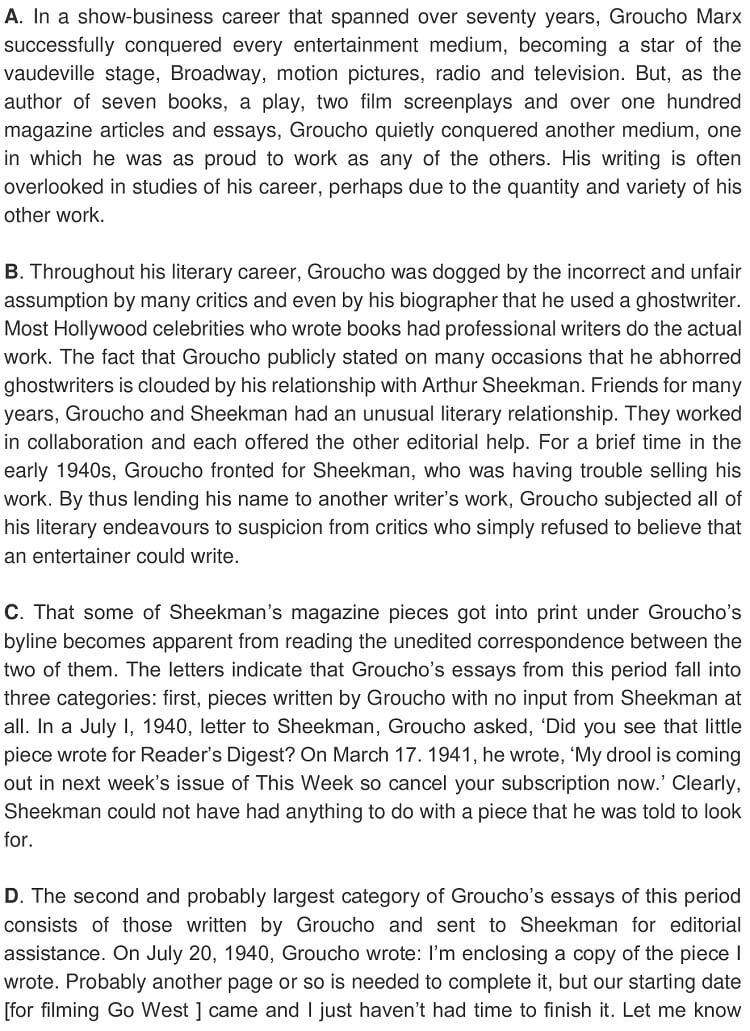
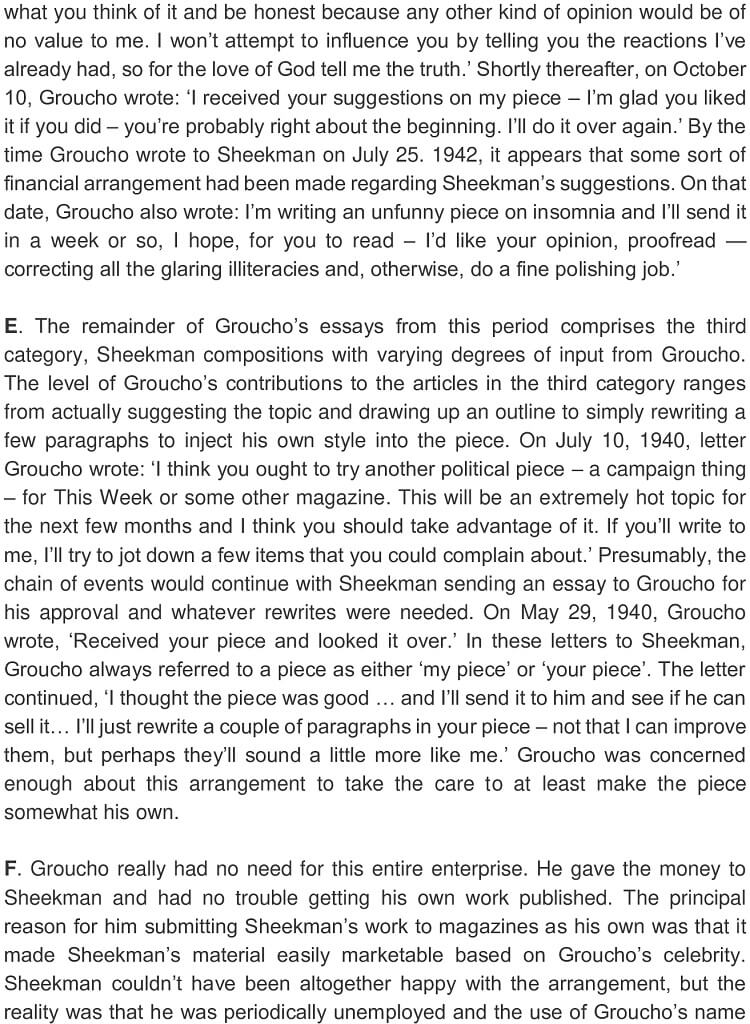

[do_widget id=custom_html-47]
Questions 1-4
Do the following statements reflect the claims of the writer of Reading Passage 1?
In boxes 1-4 on your answer sheet ante
YES, if the statement agrees with the claims of the writer
NO, if the statement contradicts the claims of the writer
NOT GIVEN, if it is impossible to say what the writer thinks about this
1 Groucho’s work as a writer was sometimes better than his work in other media.
2 Groucho’s relationship with Sheekman cast doubt on his own abilities as a writer.
3 Money was occasionally a source of disagreement between Groucho and
Sheekman.
4 Groucho occasionally regretted his involvement with Sheekman.
Questions 5-8
Complete the notes below.
Choose NO MORE THAN THREE WORDS from the passage for each answer.
Write your answers in blank spaces 5-8 on your answer sheet.
Groucho’s essays in the early 1940s
| Category 1 | Category 2 | Category 3 |
| Sheekman had 5……………. | Sheekman provided 6……………… | mostly 7…………………. |
| Groucho added 8…………………… |
Questions 9-13
Look at the following statements (Questions 9-13) and the list of dates of letters sent by Groucho to Sheekman below.
Match each statement with the letter it relates to.
Write the correct letter A-Q in boxes 9-13 on your answer sheet.
9 Groucho referred to his own inadequacy with regard to the use of language.
10 Groucho explained his reason for amending an essay.
11 Groucho agreed that part of an essay needed revising.
12 Groucho drew Sheekman’s attention to an essay soon to be published.
13 Groucho suggested that an essay should adopt a negative point of view.
List of Letters Sent by Groucho to Sheekman |
|
| A | July 1, 1940 |
| B | March 17, 1941 |
| C | July 20, 1940 |
| D | October 10, 1940 |
| E | July 25, 1942 |
| F | July 10, 1940 |
| G | May 29, 1940 |
Reading Passage 2
An Earth – Shaking discovery
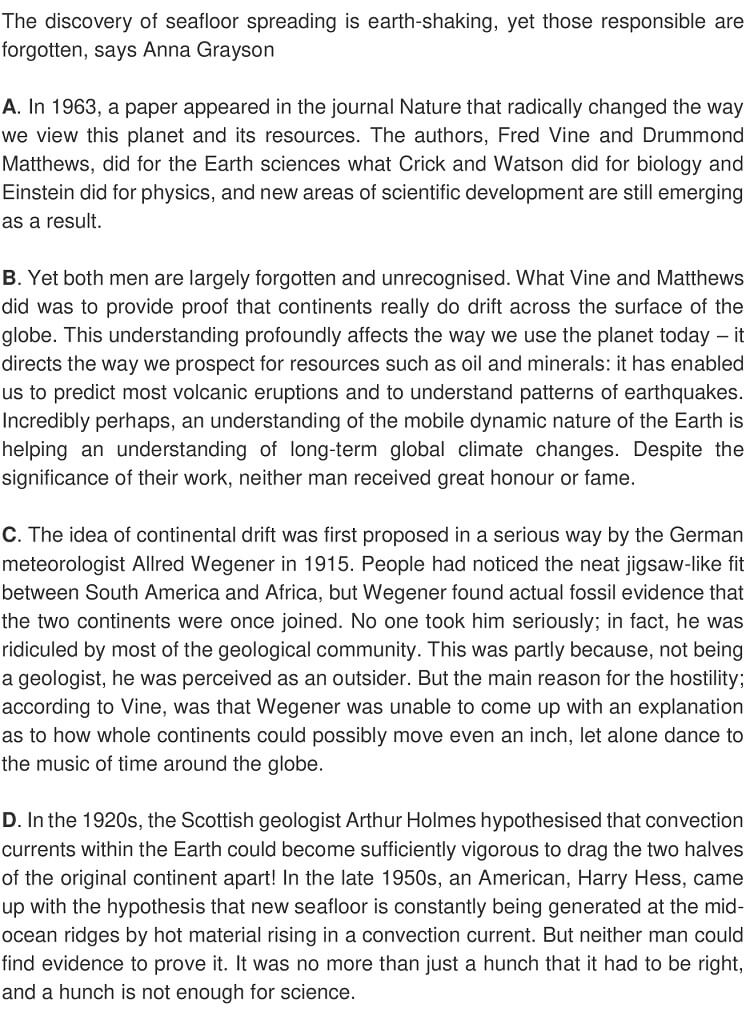
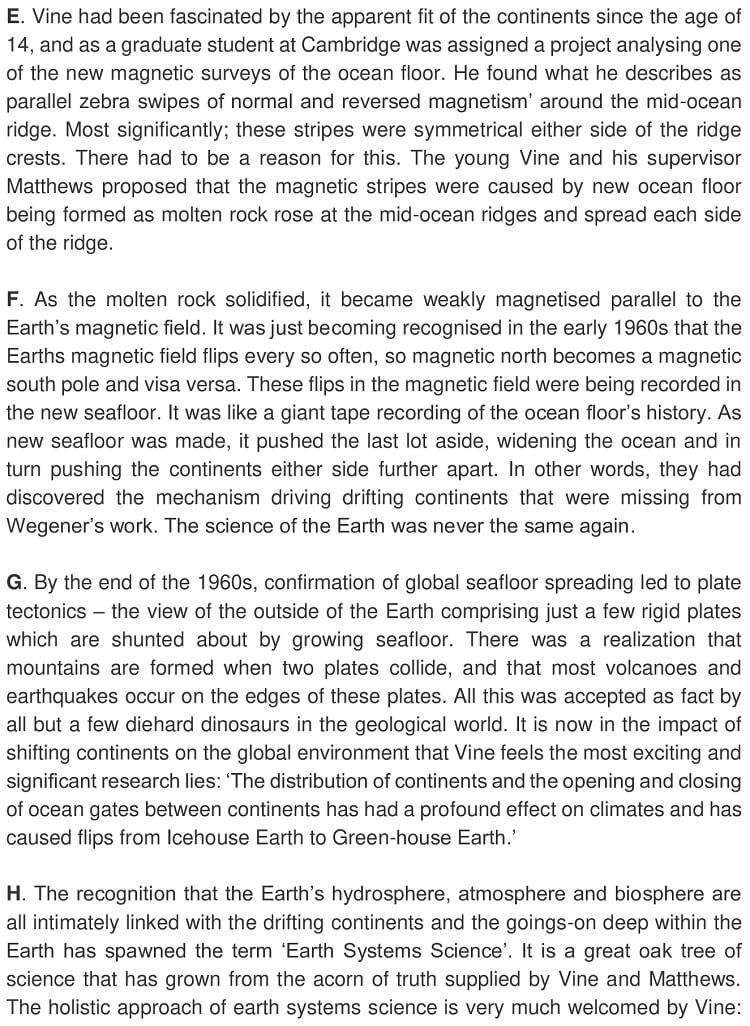

Questions 14-17
Complete each sentence with the correct ending A-Q from the box below.
Write the correct letter A-Q in boxes 14-17 on your answer sheet.
14 The work done by Vine and Matthews has had implications concerning
15 Wegener attempted to explain
16 Wegener’s conclusions were greeted as
17 The theories presented by both Holmes and Hess concerned
Questions 18-22
The discoveries of Vine and Matthews
The Ocean Floor
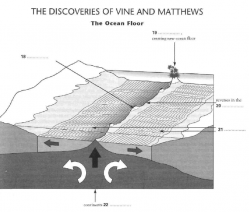
Questions 23-26
Choose NO MORE THAN THREE WORDS from the passage for each answer.
Write your answers in boxes 18-22 on your answer sheet.
Answer the questions below using NO MORE THAN THREE WORDS for each answer.
Write your answers in boxes 23-26 on your answer sheet.
23 What is the name of the theory concerning the structure of the Earth that developed from the demonstration of seafloor spreading?
24 According to Vine, what has the movement of continents had a big influence on?
25 What branch of science has emerged as a result of the work done by Vine and Matthews?
26 Which word does Vine use to describe how he believes the study of the Earth should be conducted?
Also check:
- IELTS Reading
- IELTS Reading tips
- True False Not Given IELTS Reading
- IELTS Reading recent actual test
- IELTS past paper pdf
Reading Passage 3
Think happy
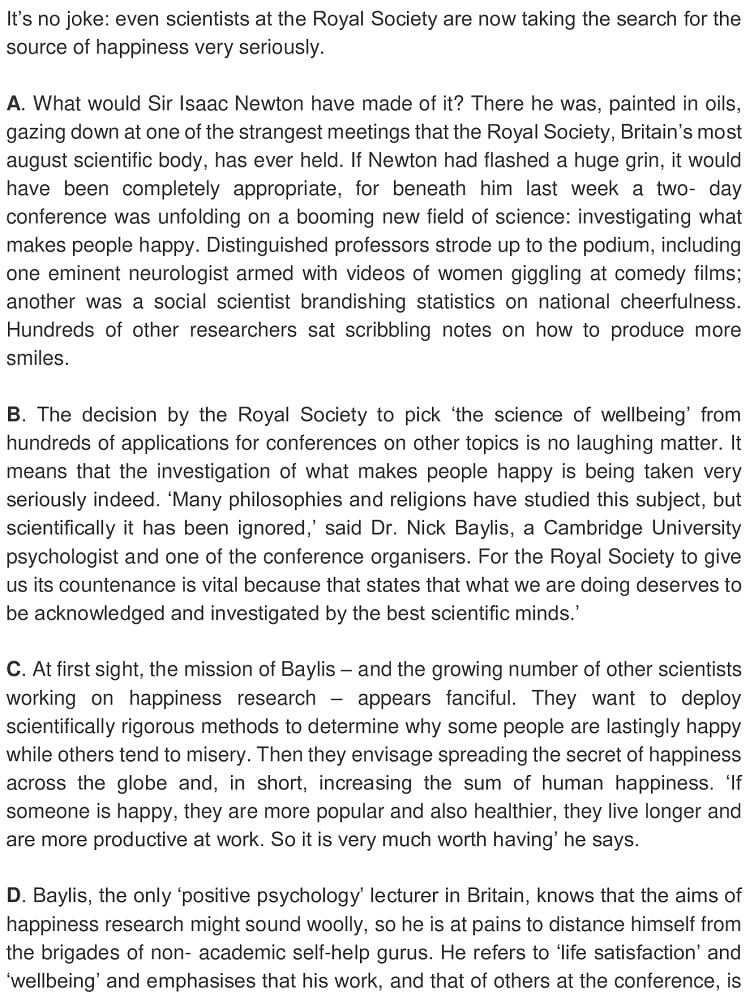

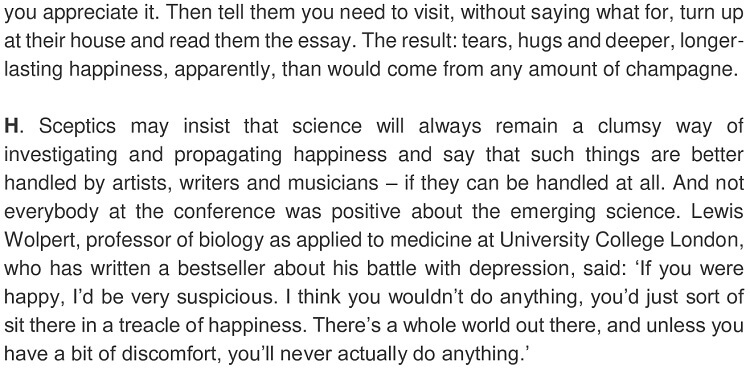
Questions 27-30
Complete the sentences below with words taken from Reading Passage 3.
Use NO MORE THAN THREE WORDS for each answer.
Write your answers in blank spaces 27-30 on your answer sheet.
27 At the conference, research into happiness was referred to as the…………………
28 Baylis and others intend to use……………………. to find out what makes people happy or unhappy.
29 Baylis gives classes on the subject of……………………….
30 Baylis says he should not be categorised among the ………………………who do not have academic credentials.
Questions 31-36
Complete the summary below using words from the box.
Write your answers in blank spaces 31-36 on your answer sheet.
Seligman’s categories of happiness
Seligman’s first type of happiness involves the enjoyment of pleasures such as
31………………… He believes that people should not be under the 32…………………. that such things lead to happiness that is not just temporary. His second type is related to 33……………………………………… Identification of this should lead to 34….………. and the result is ‘the good life’. His third type involves having a strong 35………….. and doing something about it for the benefit of others. This, according to Seligman, leads to happiness that has some 36……………….….
| confidence
thrill ability ego exaggeration |
Entertainment perseverance theory permanence concept
|
incentive
illusion celebration leadership conviction |
leadership
effort participation encouragement support |
Questions 37—40
Reading Passage 3 has eight: paragraphs labelled A-H.
Which paragraph contains the following information?
Write the correct letter A-H in boxes 37-40 on your answer sheet.
37 a view that complete happiness may not be a desirable goal
38 a reference to the potential wider outcomes of researching happiness
39 an implication of the fact that the conference was held at all
40 a statement concerning the possible outcome of expressing a certain view in
public
Answers
Unlock Answer
Signup/Login and get access to the answers
Groucho Marx Arthur Sheekman Reading Answers (Passage 1)
1.
Answer: NOT GIVEN
Question Type: Yes/No/Not Given Questions
Answer location: Paragraph A, 2nd last line
Answer explanation: We are told that Groucho was ‘as proud’ of his work as a writer as he was of his work in other media and that not enough attention is paid to his writing because he was so good at his other work, but we are not told whether or not some of his writing was better than some of his other work.
2.
Answer: YES
Question Type: Yes/No/Not Given Questions
Answer location: Paragraph B, 2nd last line
Answer explanation: We are told that “for a brief time in the early 1940s, Groucho fronted for Sheekman, who was having trouble selling his work. By thus lending his name to another writer’s work, Groucho subjected all of his literary endeavours to suspicion from critics who simply refused to believe that an entertainer could write.” Because they sometimes pretended that Sheekman’s work had been written by Groucho, some critics suspected that Groucho had not written any of the things that had his name on them. Critics were caused to believe that he wasn’t a good enough writer to have written these things.
3.
Answer: NO
Question Type: Yes/No/Not Given Questions
Answer location: Paragraph F, line 2
Answer explanation: We are told that Groucho gave the money for articles “he gave the money to Sheekman and had no trouble getting his own work published. “ Sheekman had worked on to Sheekman and that this money was useful to Sheekman because he was ‘periodically unemployed’. It is therefore clear that they did not disagree about money. Groucho was happy to give it and Sheekman needed it.
Answer: NO
Question Type: Yes/No/Not Given Questions
Answer location: Paragraph F, line 2
Answer explanation: At the end of the paragraph, “the reasons for some of their collaborative efforts not being credited as such remain unexplained, but Groucho was never shy about crediting his collaborators, and in every other case he did so.” We are told it is strange that Groucho did not include Sheekman’s name on some of the things they had produced together because he usually put collaborators’ names on things they had worked on with him. However, we do not know why he left Sheekman’s name out or whether or not this was because he sometimes regretted the arrangement – it is a mystery.
5.
Answer: no input
Question Type: Note Completion
Answer location: Paragraph C, line 2
Answer explanation: If you read thoroughly, a line in the passage specifies that “the letters indicate that Groucho’s essays from this period fall into three categories: first, pieces written by Groucho with no input from Sheekman at all.” In the first category, the essays were written by Groucho alone.
6.
Answer: editorial assistance
Question Type: Note Completion
Answer location: Paragraph D, line 3
Answer explanation: If you read thoroughly, there’s a line that claims, “probably another page or so is needed to complete it, but our starting date [for filming Go West ] came and I just haven’t had time to finish it. Let me know what you think of it and be honest because any other kind of opinion would be of no value to me.” In the second category, Groucho wrote the essays and sent them to Sheekman for him to make comments and suggest changes.
7.
Answer: Sheekman compositions
Question Type: Note Completion
Answer location: Paragraph E, line 1
Answer explanation: The answer is clearly mentioned in the said paragraph and line. In the passage, it is said that “Sheekman compositions with varying degrees of input from Groucho. The level of Groucho’s contributions to the articles in the third category ranges from actually suggesting the topic and drawing up an outline to simply rewriting a few paragraphs to inject his own style into the piece.” In the third category, Sheekman wrote most of each essay and Groucho made contributions to them of various kinds.
8.
Answer: his own style
Question Type: Note Completion
Answer location: Paragraph E, line 2
Answer explanation: In the said paragraph, refer that, “the level of Groucho’s contributions to the articles in the third category ranges from actually suggesting the topic and drawing up an outline to simply rewriting a few paragraphs to inject his own style into the piece.” For some pieces in the third category, Groucho rewrote some parts so that they had his style of writing rather than Sheekman’s.
9.
Answer: E
Question Type: Matching Information
Answer location: Paragraph D, line 8
Answer explanation: The answer is clearly mentioned in the said paragraph and line. In the passage, it is said that “by the time Groucho wrote to Sheekman on July 25. 1942, it appears that some sort of financial arrangement had been made regarding Sheekman’s suggestions. On that date, Groucho also wrote: I’m writing an unfunny piece on insomnia and I’ll send it in a week or so, I hope, for you to read – I’d like your opinion, proofread — correcting all the glaring illiteracies and, otherwise, do a fine polishing job.” In this letter, Groucho referred to his own ‘glaring illiteracies’ – obvious poor uses of language.
10.
Answer: G
Question Type: Matching Information
Answer location: Paragraph E, 2nd last line
Answer explanation: In the said paragraph, refer that, “the letter continued, ‘I thought the piece was good … and I’ll send it to him and see if he can sell it, I’ll just rewrite a couple of paragraphs in your piece – not that I can improve them, but perhaps they’ll sound a little more like me.” Groucho explained that he had changed a piece not to make it better, but so that it would have his style.
11.
Answer: D
Question Type: Matching Information
Answer location: Paragraph D, line 6
Answer explanation: A few lines in said paragraph discuss that “shortly thereafter, on October 10, Groucho wrote: ‘I received your suggestions on my piece – I’m glad you liked it if you did – you’re probably right about the beginning. I’ll do it over again.” ‘Shortly thereafter’ means ‘a short time after that’ and refers back to the letter previously mentioned, on July 20, 1940, so this letter must also have been in 1940. In this letter, Groucho says that Sheekman’s comments about the beginning of the piece are right and that therefore he will write that part again.
12.
Answer: B
Question Type: Matching Information
Answer location: Paragraph C, last line
Answer explanation: If you read thoroughly, there’s a line that claims, “my drool is coming out in next week’s issue of This Week so cancel your subscription now.’ Clearly, Sheekman could not have had anything to do with a piece that he was told to look for.” Groucho refers to a piece he calls ‘my drool’ – by this, he means ‘my rubbish’ – that is to go to be published the following week. In the letter mentioned previously in the paragraph, he refers to a piece that has already been published.
13.
Answer: F
Question Type: Matching Information
Answer location: Paragraph E, line 3
Answer explanation: The answer is clearly mentioned in the said paragraph and line. In the passage, it is said that “I think you ought to try another political piece – a campaign thing – for This Week or some other magazine. This will be an extremely hot topic for the next few months and I think you should take advantage of it. If you’ll write to me, I’ll try to jot down a few items that you could complain about.” In this letter, Groucho suggests that Sheekman should write about a political campaign and that in the piece Sheekman should ‘complain about’ various things.
An Earth – Shaking discovery Reading Answers (Passage 2)
14.
Answer: D
Question Type: Matching Sentence Endings
Answer location: Paragraph B, line 3
Answer explanation: Paragraph B provides the information that “this understanding profoundly affects the way we use the planet today – it directs the way we prospect for resources such as oil and minerals: it has enabled us to predict most volcanic eruptions and to understand patterns of earthquakes. Incredibly perhaps, an understanding of the mobile dynamic nature of the Earth is helping an understanding of long-term global climate changes.” In this paragraph, the writer says that their work has not only been important in connection with the movement of continents, it has also had a variety of other results in connection with looking for oil and minerals, learning about volcanoes and earthquakes, and understanding climate changes.
15.
Answer: E
Question Type: Matching Sentence Endings
Answer location: Paragraph C, line 2
Answer explanation: The answer is clearly mentioned in the said paragraph and line. In the passage, it is said that “people had noticed the neat jigsaw-like fit between South America and Africa, but Wegener found actual fossil evidence that the two continents were once joined.” People had observed that South America and Africa appeared to fit together very well if they were put together, and Wegener explained that they had once been joined together, using fossil evidence he had found to demonstrate this.
16.
Answer: B
Question Type: Matching Sentence Endings
Answer location: Paragraph C, line 3
Answer explanation: In the reference paragraph, the author mentions that “no one took him seriously; in fact, he was ridiculed by most of the geological community. This was partly because, not being a geologist, he was perceived as an outsider.” We are told that he was ‘ridiculed’ (laughed at) because of his theories because he was an ‘outsider’ and because he couldn’t prove that continents actually moved. His theories were therefore not considered believable.
17.
Answer: F
Question Type: Matching Sentence Endings
Answer location: Paragraph D, line
Answer explanation: In the said paragraph, you can find out that “but neither man could find evidence to prove it. It was no more than just a hunch that it had to be right, and a hunch is not enough for science.” Their theory is described as ‘just a hunch’ (a feeling that something is true, but without any evidence to prove that it is true). They felt that their theory must be correct, but they couldn’t show that it was.
18.
Answer: mid(-)ocean ridge(s) / ridge crest(s)
Question Type: Diagram Completion
Answer location: Paragraph E, last line
Answer explanation: The author in paragraph E puts forward the information that “the young Vine and his supervisor Matthews proposed that the magnetic stripes were caused by new ocean floor being formed as molten rock rose at the mid-ocean ridges and spread each side of the ridge.” All the activity described here happened on both sides of the mid-ocean ridge (a raised part in the middle of the ocean floor), particularly on each side of the ridge crests (the very top of the ridges) where the stripes appeared.
19.
Answer: molten rock rose
Question Type: Diagram Completion
Answer location: Paragraph E, last line
Answer explanation: If you read thoroughly, the author in the given paragraph mentions that “the young Vine and his supervisor Matthews proposed that the magnetic stripes were caused by new ocean floor being formed as molten rock rose at the mid-ocean ridges and spread each side of the ridge.” They decided that molten (hot and in liquid form) rock rose, with the result that new ocean floor was formed, which created the stripes.
20.
Answer: (Earth’s) magnetic field
Question Type: Diagram Completion
Answer location: Paragraph F, line 2
Answer explanation: In the said paragraph, refer that, “it was just becoming recognised in the early 1960s that the Earths magnetic field flips every so often, so magnetic north becomes a magnetic south pole and visa versa. These flips in the magnetic field were being recorded in the new seafloor. It was like a giant tape recording of the ocean floor’s history.” When the rock became solid again, the magnetic field changed around, so that north became south and south became north. ‘Flips’ are changes from one side to the other.
Answer: parallel/symmetrical/magnetic (zebra) stripes
Question Type: Diagram Completion
Answer location: Paragraph E, line 3
Answer explanation: In the said paragraph, you can refer to, “he found what he describes as parallel zebra swipes of normal and reversed magnetism’ around the mid-ocean ridge. Most significantly; these stripes were symmetrical either side of the ridge crests. There had to be a reason for this.” The stripes formed are described firstly as ‘parallel zebra stripes’ and they are then described as being ‘symmetrical’ and ‘magnetic’.
22.
Answer: pushed aside/(further) apart
Question Type: Diagram Completion
Answer location: Paragraph F, line 5
Answer explanation: A line in the said paragraph infers that “as new seafloor was made, it pushed the last lot aside, widening the ocean and in turn pushing the continents either side further apart.” the creation of new seafloor meant that the continents on either side of the ocean moved further away from each other.
23.
Answer: plate tectonics
Question Type: Short Answer Questions
Answer location: Paragraph H, line 1
Answer explanation: If you read thoroughly, there’s a line in the said paragraph that describes “the recognition that the Earth’s hydrosphere, atmosphere and biosphere are all intimately linked with the drifting continents and the goings-on deep within the Earth has spawned the term ‘Earth Systems Science’.” This term is given to the theory that resulted from proof that the seafloor spreads.
24.
Answer: climates
Question Type: Short Answer Questions
Answer location: Paragraph G, last line
Answer explanation: A line in the said paragraph infers that “the distribution of continents and the opening and closing of ocean gates between continents has had a profound effect on climates and has caused flips from Icehouse Earth to Green-house Earth.” ‘The distribution of Vine says that the movement of continents has had ‘a profound effect’ (an enormous influence) on climates and has caused some huge climate changes.
25.
Answer: earth systems science
Question Type: Short Answer Questions
Answer location: Paragraph H, line 1
Answer explanation: The opening line of paragraph H puts forward the information that “the recognition that the Earth’s hydrosphere, atmosphere and biosphere are all intimately linked with the drifting continents and the goings-on deep within the Earth has spawned the term ‘Earth Systems Science’.” Their work led to an understanding that there was a link between the movement of continents and the other things listed, and this ‘spawned’ (led to the birth of) this new branch of science.
26.
Answer: integrated
Question Type: Short Answer Questions
Answer location: Paragraph H, line 4
Answer explanation: If you observe, in the said paragraph to the fact that “he feels that the future for understanding the planet lies in an integrated approach to the sciences, rather than the isolated stance the geologists took throughout the 20th century: There was an incredible polarisation of science and I was caught between the boundaries.” He thinks there should be an ‘integrated approach’ and is quoted as saying that ‘the whole of environmental science should be integrated’. He says that he really disliked (it was ‘anathema’ to him) the idea that science was separated into completely separate areas (the ‘polarisation’).
Think happy Reading Answers (Passage 3)
27.
Answer: the science of wellbeing
Question Type: Sentence Completion
Answer location: Paragraph B, line 1
Answer explanation: The opening line of paragraph B suggest that “the decision by the Royal Society to pick ‘the science of wellbeing’ from hundreds of applications for conferences on other topics is no laughing matter. It means that the investigation of what makes people happy is being taken very seriously indeed.” The use of inverted commas means that the writer is quoting the term used for the subject of the conference.
28.
Answer: scientifically rigorous methods
Question Type: Sentence Completion
Answer location: Paragraph C, line 2
Answer explanation: If you observe clearly, in the reference paragraph it is given that “they want to deploy scientifically rigorous methods to determine why some people are lastingly happy while others tend to misery. Then they envisage spreading the secret of happiness across the globe and, in short, increasing the sum of human happiness.” They want to ‘deploy’ (use) such methods to find out why some people are happy all the time and others are often miserable.
29.
Answer: scientifically rigorous methods
Question Type: Sentence Completion
Answer location: Paragraph D, line 1
Answer explanation: If you read thoroughly, a line in the passage specifies that “baylis, the only ‘positive psychology’ lecturer in Britain, knows that the aims of happiness research might sound woolly, so he is at pains to distance himself from the brigades of non- academic self-help gurus.” He is a lecturer in this subject. Again, the inverted commas mean that this is the actual term used for his subject when he is teaching it.
30.
Answer: self-help gurus
Question Type: Sentence Completion
Answer location: Paragraph D, line 1
Answer explanation: The answer is clearly mentioned in the said paragraph and line. In the passage, it is said that “baylis, the only ‘positive psychology’ lecturer in Britain, knows that the aims of happiness research might sound woolly, so he is at pains to distance himself from the brigades of non- academic self-help gurus.” He accepts that this area of research may sound ‘woolly’ (imprecise) and ‘is at pains to distance himself from’ (is very keen not to be included among) the groups of people who consider themselves experts on how people can help themselves, but who have no academic background for this.
31.
Answer: entertainment
Question Type: Summary Completion
Answer location: Paragraph F, line 2
Answer explanation: Paragraph F puts forward the information that “first, there is ‘the pleasant life’ – the kind of happiness we usually gain from sensual pleasures such as eating and drinking or watching a good film.” One of the things that cause his first type of happiness is ‘watching a good film’, which is a form of entertainment.
32.
Answer: illusion
Question Type: Summary Completion
Answer location: Paragraph F, line 2
Answer explanation: Few lines in said paragraph discusses that “Seligman blames Hollywood and the advertising industry for encouraging the rest of us, wrongly as he sees it, to believe that lasting happiness is to be found that way.” He thinks that people are given the false belief that these things lead to ‘lasting happiness’. If you are ‘under the illusion’ that something is true, you have a false belief that something, usually something good, is true.
33.
Answer: ability
Question Type: Summary Completion
Answer location: Paragraph F, line 4
Answer explanation: In the reference paragraph, the author mentions that “secondly, there is ‘the good life’, which comes from enjoying something we are good or talented at.” His second type of happiness comes from being good or talented at’ something, which means that it is connected with your ability at something.
34.
Answer: participation
Question Type: Summary Completion
Answer location: Paragraph F, line 4
Answer explanation: “The key to this, Seligman believes, lies in identifying our strengths and then taking part in an activity that uses them.” This reference line from the passage conveys that he believes that this type of happiness comes from identifying what you are good at and ‘taking part in’ things that use your abilities. ‘Participation’ means ‘taking part’.
35.
Answer: conviction
Question Type: Summary Completion
Answer location: Paragraph F, line 5
Answer explanation: In the said paragraph, you can find out that “third, there is ‘meaningful life’. The most lasting happiness, Seligman says, comes from finding something you believe in and then putting your strengths at its service.” His third type of happiness involves finding something you ‘believe in’ and then taking action to help others in connection with this belief. A conviction is a strong belief, especially a moral one.
36.
Answer: permanence
Question Type: Summary Completion
Answer location: Paragraph F, last line
Answer explanation: Last line of paragraph F conveys that “people who are good at communicating with others might thus find long-lasting happiness through becoming involved in politics or voluntary work, while a rock star wanting to save the world might find it in organising a charity concert.” Involvement in things you strongly believe in can lead to ‘long-lasting happiness’, according to Seligman. If something is long-lasting, it has permanence, rather than being only temporary.
37.
Answer: H
Question Type: Matching Information
Answer location: Paragraph H, line 3
Answer explanation: A line in the given paragraph suggests that “Lewis Wolpert, professor of biology as applied to medicine at University College London, who has written a bestseller about his battle with depression, said: If you were happy, I’d be very suspicious. I think you wouldn’t do anything, you’d just sort of sit there in a treacle of happiness. There’s a whole world out there, and unless you have a bit of discomfort, you’ll never actually do anything.” Lewis Wolpert says that he would not trust someone who was ‘totally happy’, and he would regard them as being incapable of doing anything. He thinks that people need some ‘discomfort’ in order for them to do anything.
38.
Answer: C
Question Type: Matching Information
Answer location: Paragraph C, line 2
Answer explanation: From the given information “They want to deploy scientifically rigorous methods to determine why some people are lastingly happy while others tend to misery. Then they envisage spreading the secret of happiness across the globe and, in short, increasing the sum of human happiness. ” We can infer that Baylis and his colleagues want to find out what makes people happy and then use this information to make people happier. They think this may affect people’s social lives, their health, how long they live and how good they are at work.
39.
Answer: B
Question Type: Matching Information
Answer location: Paragraph B, line 1
Answer explanation: The opening line of paragraph B suggests that “the decision by the Royal Society to pick ‘the science of wellbeing’ from hundreds of applications for conferences on other topics is no laughing matter. It means that the investigation of what makes people happy is being taken very seriously indeed.” The fact that the conference is being held at such an important place as the Royal Society indicates that the subject ‘is being taken very seriously indeed’.
40.
Answer: E
Question Type: Matching Information
Answer location: Paragraph E, line
Answer explanation: “For a less well- known scientist, the speech could have spelt the end of a career, but instead, Seligman landed funding of almost £18m to follow his hunch.” This information suggests that Seligman asked why science investigated unhappiness but not happiness. This shocked people who heard him and, if he had not been so well-known, it ‘could have spelt the end of his career’. People would have found his words unacceptable, and he would have been unable to find work as a result.
Practice IELTS Reading based on question types

Start Preparing for IELTS: Get Your 10-Day Study Plan Today!
Explore other Reading Practice Tests

Kasturika Samanta

Kasturika Samanta

Nehasri Ravishenbagam
Recent Articles

Nehasri Ravishenbagam

Haniya Yashfeen

Haniya Yashfeen

Haniya Yashfeen





Post your Comments
1 Comment